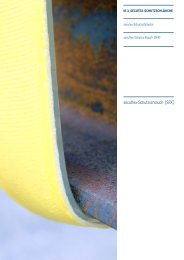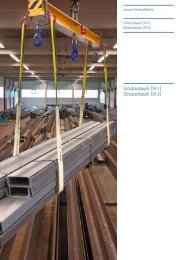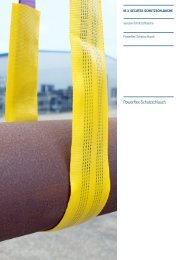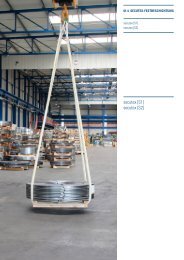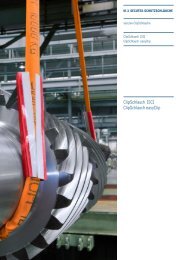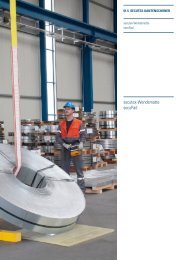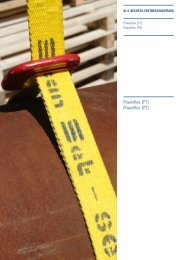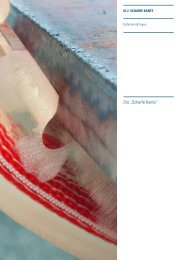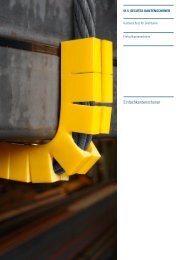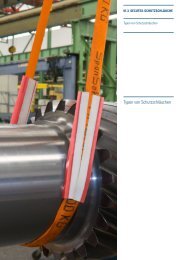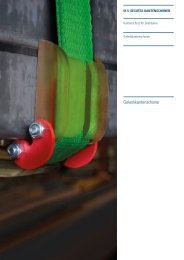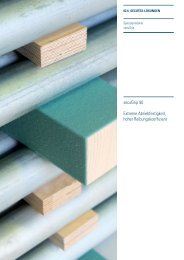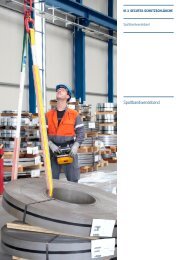AXZION GKS - Q7.pdf
You also want an ePaper? Increase the reach of your titles
YUMPU automatically turns print PDFs into web optimized ePapers that Google loves.
D01–Engineering–1–08/14 I © <strong>AXZION</strong>-<strong>GKS</strong> Stahl- und Maschinenbau GmbH, Germany, 2014<br />
2<br />
3
Table of Contents<br />
Topics 6<br />
01.1 Consultation 18<br />
Standard or customised solutions 22<br />
Position of the load’s centre of gravity 23<br />
01.2 Design 24<br />
Specialisation as a means of designing<br />
optimal lifting equipment 26<br />
Load changes 27<br />
Up to 20,000 load changes 28<br />
Operating temperatures 29<br />
Lifting speed 29<br />
Specific operating conditions 31<br />
01.3 Materials 32<br />
Best components for<br />
optimum performance 35<br />
All materials are certified 36<br />
Flame cutting 36<br />
Documented usage list 36<br />
01.4 Manufacture 38<br />
DIN EN 1090 41<br />
Support during manufacture 44<br />
Certified welders 44<br />
Modern manufacturing machinery 45<br />
A high level of efficiency<br />
keeps prices to a minimum 45<br />
01.5 Drive units and control engineering 46<br />
Hydraulic components 50<br />
Electronic components 50<br />
Remote control 51<br />
Cameras/spotlights 51<br />
01.6 Testing and documentation 52<br />
Welded joints and materials testing 54<br />
600 t test bench 57<br />
1500 t test bench 57<br />
<strong>AXZION</strong>-DocuManager 58<br />
01.7 Service 60<br />
Tests pursuant to the German<br />
Accident Prevention Regulations 62<br />
Repairs and maintenance 62<br />
24h/7 Service 65<br />
Training and operation 65<br />
Risk analysis/assessment 66<br />
Handling instructions 67<br />
Standards, regulations<br />
and bodies of rules 68<br />
4<br />
5
Topics<br />
Precise planning guarantees optimum<br />
performance<br />
Specialisation as a means of designing<br />
optimal lifting equipment<br />
Drive units and control engineering<br />
Materials and process testing<br />
Obtaining the right advice is always a matter<br />
of going to the right place. As a manufacturer,<br />
<strong>AXZION</strong>-<strong>GKS</strong> is perfectly placed to find and<br />
implement effective solutions for its clients.<br />
More than twenty experienced design engineers<br />
specialising in lifting equipment and with expert<br />
knowledge in structural analysis, welding and<br />
drive technology design the optimal solutions for<br />
your needs.<br />
Advanced lifting equipment is increasingly fitted<br />
with electromechanical or hydraulic drive units.<br />
Extremely high demands are placed on the<br />
equipment’s control systems.<br />
Our work is verified by in-house or independent<br />
testers using state-of-the-art testing equipment.<br />
Needless to say, all certificates are readily<br />
available.<br />
Construction of the lifting equipment<br />
Specific operating conditions<br />
Load tests using in-house test benches<br />
Equipment is correctly documented<br />
The number of load changes is key. The intensity<br />
with which the lifting equipment will be used<br />
must be taken into account in order for it to be<br />
constructed correctly.<br />
Not all lifting equipment is used with a crane. If, for<br />
example, the equipment is being designed for use<br />
with a forklift truck or at sea, the equipment must<br />
be designed differently to reflect this.<br />
Stringent requirements are placed on lifting accessories<br />
and equipment. Our two in-house test<br />
benches are capable of carrying out both manual<br />
and computer-aided tests on equipment loaded<br />
with excess weight.<br />
Lifting equipment must always be delivered with<br />
comprehensive documentation, which contains<br />
information that is just as important as the<br />
manufactured product itself.<br />
Which materials are used?<br />
<strong>AXZION</strong>-<strong>GKS</strong> is extremely well qualified<br />
Maintenance, repairs and operation<br />
Handling instructions<br />
It is only possible to manufacture a safe, highquality<br />
solution using excellent components. For<br />
many years, we have only been working with the<br />
best suppliers of steel and building components.<br />
In addition to using certified welders and modern<br />
manufacturing machinery, specialist welding<br />
engineers are on hand to provide support during<br />
the production process.<br />
Minimising downtimes during operation is one<br />
of the important tasks carried out by the service<br />
team.<br />
<strong>AXZION</strong>-<strong>GKS</strong> employs highly qualified experts in<br />
lifting technology as well as specialised graphic<br />
designers to create this documentation and<br />
carries out this work in collaboration with the<br />
equipment operators.<br />
6<br />
7
Why our clients<br />
are our driving force.<br />
8<br />
9
Why advanced<br />
lifting equipment is like a<br />
good insurance policy.<br />
10<br />
11
The SpanSet Group is an international specialist<br />
in the lifting and securing of loads.<br />
With subsidiaries in all major developed countries<br />
and a global network of representatives, SpanSet<br />
is well versed in current regulations and can<br />
provide comprehensive on-site services.<br />
We manufacture a variety of products, from fibres<br />
and trusses, to ratchets, lashing straps, steel<br />
components and the lifting equipment itself.<br />
As a manufacturer, we are able to provide you<br />
with tailor-made equipment and customised<br />
solutions that fulfil the stringent requirements<br />
that must be met when transporting and<br />
assembling wind turbines and other large-scale<br />
components.<br />
12<br />
13
We take responsibility<br />
A manufacturer is “responsible for designing<br />
and producing products” that are placed on the<br />
market bearing its name.<br />
Why our expert knowledge<br />
translates into responsibility.<br />
As soon as an operator designs and produces its<br />
own lifting equipment, it automatically becomes<br />
a manufacturer. Time and time again, insufficient<br />
attention is paid to the risks and liabilities<br />
involved in lifting and moving heavy loads, which<br />
sometimes has dramatic consequences for those<br />
responsible and those affected.<br />
Always buy lifting equipment from a specialist<br />
and remember that choosing an unqualified manufacturing<br />
company may lead to those making<br />
this choice being held personally liable.<br />
With certifications ranging from the<br />
manufacturer’s qualification for fusion welding<br />
pursuant to DIN EN ISO 3834-2 and the DIN EN<br />
1090-1 manufacturer certification, to an in-house<br />
factory production control system for structural<br />
components up to EXC3 pursuant to EN 1090-2<br />
and a quality management system certified according<br />
to DIN EN ISO 9001, you can rest assured<br />
that you are purchasing from a company that<br />
complies with all the relevant regulations.<br />
14<br />
15
From design, welding and testing to documentation<br />
and service, large-scale projects often involve<br />
a number of companies working simultaneously.<br />
This process is rather challenging, as each party<br />
must complete its work in full before the next<br />
stage can begin.<br />
Why does lifting equipment provide<br />
a competitive advantage?<br />
Responsibility is sometimes not clearly divided<br />
between the various companies and opportunities<br />
that could be gained through using modern<br />
manufacturing machinery are often missed.<br />
<strong>AXZION</strong>-<strong>GKS</strong> provides everything from one<br />
source.<br />
<strong>AXZION</strong>-<strong>GKS</strong> provides everything from one<br />
source. Development, manufacture and service<br />
are closely linked, any problems that may arise<br />
are resolved quickly and the design is tailored<br />
perfectly to the latest manufacturing techniques.<br />
Our service team is on hand immediately in the<br />
event of any difficulties and we provide on-site<br />
instruction to your employees on how to use the<br />
lifting equipment supplied by us.<br />
The enormous investments currently being made<br />
into renewable energy as well as the production<br />
of oil and gas are resulting in a growing need for<br />
large-scale lifting equipment. The weight of individual<br />
elements is increasing rapidly and many<br />
units are preassembled before transportation. In<br />
some cases, lifting solutions are needed urgently<br />
and the cost of not having lifting equipment can<br />
be extremely high. <strong>AXZION</strong>-<strong>GKS</strong> is capable of<br />
very quickly supplying complete units that have<br />
been comprehensively tested by companies such<br />
as DEKRA or Germanischer Lloyd or by our inhouse<br />
600 t or 1,500 t test benches.<br />
16<br />
17
01. 1<br />
Consultation<br />
18<br />
19
Secutex-Prallschutz<br />
Precise planning guarantees optimum performance<br />
Close contact with the operator is maintained as<br />
early as the planning stage to enable us to create<br />
the perfect design. The use of state-of-the-art 3D<br />
CAD systems and computer-assisted calculation<br />
programs (FEM) enables the designs to be subsequently<br />
edited or amended at any time. When<br />
consulting with our clients, our well-trained team<br />
of experienced consultants applies the knowledge<br />
gained from working out past solutions. During<br />
these consultations, our application engineers<br />
are happy to visit clients on site to assess their<br />
operating conditions and requirements. Certain<br />
company-specific circumstances may mean that<br />
a more detailed risk analysis is necessary. Please<br />
do not hesitate to contact us if you require an<br />
on-site assessment.<br />
20<br />
21
01.1 CONSULTATION<br />
Advanced lifting equipment<br />
Advanced<br />
lifting equipment<br />
Standard or customised solutions<br />
Obtaining the right advice is always a matter of<br />
going to the right place. As a manufacturer, we<br />
are perfectly placed to find the right solution for<br />
you.<br />
This applies in terms of both price and the system<br />
itself. The fact that approximately 84% of the<br />
solutions provided by us are modified or entirely<br />
customised constructions speaks volumes.<br />
Only one sixth of the lifting equipment that leaves<br />
our factory is a standard design.<br />
Standard or customised solutions<br />
We provide the right advice<br />
By carrying out its own design and manufacturing<br />
work, <strong>AXZION</strong>-<strong>GKS</strong> has a variety of individual<br />
construction elements at its fingertips that can be<br />
assembled as required to create a comprehensive<br />
modular solution.<br />
Our strength lies in the fact that we are able to<br />
create and deliver custom-built machinery in a<br />
short space of time. We find the right solution for<br />
you, be it an affordable standard construction or a<br />
customised design.<br />
Position of the load’s centre of gravity<br />
It is imperative that the designers are made<br />
aware of the precise location of the load’s centre<br />
of gravity and the position of the load-attachment<br />
points. To this end, a technical consultation is<br />
compulsory and extra design features may be<br />
necessary.<br />
The load’s centre of gravity always lies directly<br />
below the crane hook and, where required,<br />
the load and the lifting equipment are tilted to<br />
achieve this.<br />
Here, it should be taken into account that in<br />
accordance with DIN EN 13155 unplanned inclinations<br />
to lifting beams must not exceed 6°; this<br />
must be observed when designing the equipment.<br />
Angles of inclination greater than 6° must be<br />
reported individually and secured using special<br />
design features.<br />
Attaching a load below its centre of gravity may<br />
lead to instability that, at worst, results in the<br />
load suddenly shifting position.<br />
22<br />
23
01. 2<br />
Design<br />
24<br />
25
01.2 DESIGN<br />
Experience and<br />
state-of-the-art technology<br />
Experience and<br />
state-of-the-art technology<br />
Specialisation as a means of<br />
designing optimal lifting equipment<br />
More than twenty experienced design engineers<br />
specialising in lifting equipment and with expert<br />
knowledge in structural analysis, welding and<br />
drive technology design the optimal solutions for<br />
your needs.<br />
To do so, personal consultations are often<br />
required. Our developers work at our various locations<br />
around the world, including in your area.<br />
Continuing professional development is very<br />
important at <strong>AXZION</strong>-<strong>GKS</strong> and all employees<br />
receive ongoing training.<br />
Specialists from the certification bodies DEKRA<br />
and TÜV, our professional association and renowned<br />
suppliers ensure that our knowledge is updated<br />
regularly so that we are able to comply with<br />
new standards as soon as they are introduced.<br />
New knowledge is communicated to all members<br />
of staff and experienced developers train our new<br />
employees.<br />
Our developers work with modern computers and<br />
the latest software. Designs are created in 3D<br />
using SolidWorks and are verified using the integrated<br />
FEM software, while structural analyses<br />
are carried out using MathCad or RSTAB.<br />
Load changes<br />
The number of load changes is key. The design<br />
engineer of a piece of lifting equipment must<br />
work with the operator to establish whether DIN<br />
EN 13155 “Cranes – Safety – Non-fixed load<br />
lifting attachments” may be used or whether the<br />
lifting equipment must be constructed in accordance<br />
with Eurocode 3 – DIN EN 1993 “Design<br />
and construction of steel structures”.<br />
The intensity with which the lifting equipment<br />
will be used must be taken into account in order<br />
for it to be constructed correctly. The following<br />
criteria are used to calculate the lifting intensity.<br />
Example calculation for design “A”<br />
Service life<br />
4 years<br />
250 working days<br />
One-shift operation<br />
Number of lifting operations a day 2<br />
Load changes per lifting operation 2<br />
Calculation 4 x 250 x 2 x 2<br />
Result 4.000<br />
Standard applied DIN EN 13155<br />
Factors for determining the design<br />
Planned service life<br />
Number of lifting<br />
operations a day<br />
Load changes per<br />
lifting operation<br />
Operating life in years<br />
Example calculation for design “B”<br />
According to the VBG 9a<br />
regulation on lifting equipment,<br />
multiple-shift operation occurs<br />
when there are > 20,000 load<br />
changes<br />
A load change occurs when the<br />
lifting equipment changes from<br />
not carrying a load to carrying a<br />
load that weighs at least 50%<br />
of the maximum permissible<br />
load-carrying capacity of the<br />
lifting equipment<br />
Service life<br />
10 years<br />
250 working days<br />
One-shift operation<br />
Number of lifting operations a day 40<br />
Load changes per lifting operation 4<br />
Calculation 10 x 250 x 40 x 4<br />
Result 400.000<br />
Standard applied<br />
Eurocode 3-DIN<br />
EN 1993<br />
26<br />
27
01.2 DESIGN<br />
Experience and<br />
state-of-the-art technology<br />
Experience and<br />
state-of-the-art technology<br />
Up to 20,000 load changes<br />
If the lifting equipment being designed is<br />
expected to deal with a maximum of 20,000 load<br />
changes, EN 13155 “Cranes – Safety – Non-fixed<br />
load lifting attachments” is applied in full. This<br />
means that the mechanical load-bearing components<br />
must meet the following mechanical stability<br />
requirements:<br />
I) The dimensions of the lifting equipment must<br />
be arranged in such a way that the machinery is<br />
able to bear a static load that is three times its<br />
load-bearing capacity and hold the load, even<br />
if doing so results in permanent changes to its<br />
shape.<br />
I) The dimensions of the lifting equipment must<br />
be arranged in such a way that it is able to bear a<br />
static load that is double its load-bearing capacity<br />
without any permanent changes to its shape.<br />
III) A further significant requirement is laid down<br />
in paragraph 6 of EN 13155. It states that individually<br />
designed and manufactured products must<br />
undergo both a design inspection and an individual<br />
inspection. With standard products produced<br />
in series, the design inspection must be carried<br />
out on one or multiple sample products from<br />
the production line and the individual inspection<br />
must be carried out on each of the manufactured<br />
products.<br />
IV) The manufacturer of the lifting equipment<br />
must provide evidence that the welding was<br />
carried out by personnel qualified to the standard<br />
of EN 287-1 or DIN EN ISO 9606-1 “Qualification<br />
testing of welders – Fusion welding”. Furthermore,<br />
the quality of the welded joints must be<br />
verified in accordance with DIN EN ISO 5817<br />
“Evaluation of welded joints”.<br />
Operating temperatures<br />
The designers must be made aware of the<br />
operating temperatures. Standard lifting<br />
equipment is used in temperatures of between<br />
0 °C and +80 °C.<br />
When used outdoors, temperatures may fall to<br />
-20 °C and in some regions of the world,<br />
temperatures as low as -40 °C are possible. In<br />
such conditions, low-temperature steels are used.<br />
When hot loads are lifted, on the other hand,<br />
extremely high operating temperatures may<br />
arise and here, special types of steel capable of<br />
withstanding such operating conditions must be<br />
chosen.<br />
Lifting speed<br />
Safety information<br />
Please take note of any changes in the operating<br />
conditions (e.g. a change to the usage frequency<br />
if the lifting equipment is moved to a different<br />
department).<br />
DIN EN 13155 does not cover the dangers concerning<br />
the mechanical stability of lifting equipment<br />
which is intended to undergo more than 20,000<br />
load changes. As a result, it is imperative that<br />
lifting equipment designed in accordance with<br />
DIN EN 13155 is withdrawn from service as soon<br />
as 20,000 load changes have been performed.<br />
The lifting equipment must be designed in line<br />
with the speed at which the loads will be lifted.<br />
In general, the maximum lifting speed is<br />
10 m/sec. To make the loading process quicker,<br />
much higher speeds are possible at cargo<br />
handling companies (ports, steel works, etc.), for<br />
example. These speeds must be communicated<br />
to the designers in advance.<br />
28<br />
29
01.2 DESIGN<br />
Experience and<br />
state-of-the-art technology<br />
Experience and<br />
state-of-the-art technology<br />
Specific operating conditions<br />
Forklift truck<br />
Not all lifting equipment is used with a crane.<br />
For example, lifting equipment is often used with<br />
a forklift truck.<br />
This results in significantly higher dynamic<br />
load conditions. Moreover, the lifting speed is<br />
generally much greater than with a normal crane.<br />
The possible use of the lifting equipment with<br />
a forklift truck may result in many load changes<br />
taking place in very quick succession and it is<br />
essential that this is taken into account during<br />
the design phase.<br />
Offshore<br />
The requirements placed on lifting equipment<br />
used at sea are particularly stringent and, as<br />
a result, the design and production stages are<br />
strictly regulated.<br />
The dynamic forces produced by the wind and<br />
waves may be enormous, making working at<br />
sea dangerous. Lifting equipment used in these<br />
conditions must therefore be easy to operate and<br />
extremely safe.<br />
By providing us with detailed information on how<br />
you wish to use your lifting device, we will be<br />
able to design the right equipment for your needs.<br />
31
01. 3<br />
Materials<br />
32<br />
33
Best components for optimum performance<br />
It is only possible to manufacture a safe, highquality<br />
solution using excellent components. For<br />
many years, we have only been working with the<br />
best suppliers of steel and, as such, our tested<br />
blasted steels are mainly obtained from Arcelor,<br />
UnionStahl, ThyssenKrupp and Carl Spaeter.<br />
When selecting the sheet metal to be processed,<br />
we not only focus on optimum weldability<br />
(lowering the risk of cold cracks, for example)<br />
and excellent machinability, but also look for<br />
fine-grained steels with high levels of strength<br />
and resistance.<br />
We frequently choose to work with various<br />
thermomechanically rolled steels (TM steels for<br />
short).<br />
The stainless steels used must have outstanding<br />
levels of resistance against a number of<br />
corrosive substances as well as a high resistance<br />
to oxidation. More often than not, these criteria<br />
result in us choosing to work with austenitic (nonmagnetic)<br />
steels with a nickel content of >= 2.5%<br />
(from material number 1.44...).<br />
Chain components<br />
We mostly obtain our chain components from<br />
RUD’s chain factory in Aalen, our shackles from<br />
van Beest and our wire ropes from Henschel.<br />
Renowned companies specialising in closed-die<br />
forging, such as RUD Schöttler Umformtechnik &<br />
Systemlieferant in Hagen, supply our crane hooks<br />
and lifting eyes.<br />
secutex<br />
SpanSet-secutex is the leading manufacturer<br />
of plastic components for protecting materials.<br />
Thanks to its excellent mould-making skills, the<br />
company is able to produce tailor-made solutions<br />
rapidly and cost effectively. Efficient planning is<br />
essential. secutex impact protection elements form<br />
an integral part of the lifting equipment supplied.<br />
The parts subject to wear can be changed quickly<br />
and easily.<br />
SpanSet<br />
Textile lifting accessories, such as trusses and<br />
round slings, of course come from our parent<br />
company SpanSet. SpanSet’s large manufacturing<br />
plant in Übach-Palenberg is able to find solutions<br />
even for super heavy-duty lifting. Repairs and<br />
express deliveries ensure that the lifting equipment<br />
supplied by us is readily available.<br />
34<br />
35
01.3 MATERIALS<br />
Materials from<br />
renowned manufacturers<br />
Materials from<br />
renowned manufacturers<br />
All materials are certified<br />
We require that the manufacturers of all the<br />
materials used have been awarded at least a 3.1<br />
inspection certificate in accordance with DIN EN<br />
10204. For equipment that is to be used offshore,<br />
a 3.2 inspection report in accordance with DIN<br />
EN 10204 may also need to be compiled by an<br />
independent expert commissioned by the manufacturer.<br />
Delivered materials are only approved for<br />
use in our manufacturing plant once our appropriately<br />
qualified employees have performed a<br />
systematic inspection of the incoming goods.<br />
Flame cutting<br />
We place huge importance on top combustion<br />
quality and the complete traceability of the materials<br />
used. Flame-cut parts are produced using<br />
modern CNC-controlled flame or plasma cutting<br />
machines, while processing is carried out using<br />
state-of-the-art trimmers.<br />
Documented usage list<br />
Steel is only used in the manufacturing process<br />
if the appropriate inspection certificates and/<br />
or inspection reports are in place and once the<br />
material has been approved by our in-house<br />
quality assurance team. All material certificates,<br />
inspection reports and usage lists are managed<br />
and archived on a computer system, meaning<br />
that they remain available indefinitely and can be<br />
retrieved at any time.<br />
36<br />
37
01. 4<br />
Manufacture<br />
38<br />
39
secutex-Anfahrtschutz<br />
DIN EN 1090<br />
DIN EN 1090 officially came into force on 1<br />
January 2011. In order to obtain approval from<br />
building officials across Europe to manufacture<br />
steel constructions, companies must meet the<br />
applicable technical standards. Only companies<br />
that fulfil the requirements laid down in this standard<br />
and which have been inspected and certified<br />
by a recognised body may be commissioned to<br />
manufacture metal structures (e.g. welded steel<br />
structures).<br />
Companies that wish to manufacture welded<br />
steel structures or perform welding on existing<br />
steel structures must prove that they have<br />
suitably qualified employees and the required<br />
technical equipment. Certified companies must<br />
arrange regular inspections to ensure that they<br />
are still working in line with the standard. Among<br />
other aspects, conforming to this standard<br />
involves working in compliance with the quality<br />
requirements laid down in DIN EN ISO 3834 in<br />
the appropriate level of quality.<br />
To obtain approval from building officials to<br />
manufacture structural components, companies<br />
must fulfil the following requirements pursuant to<br />
DIN EN 1090.<br />
Part 1<br />
Requirements for conformity assessment for<br />
structural components<br />
Part 2<br />
Technical requirements for the execution of steel<br />
structures<br />
The requirements to be fulfilled are determined<br />
by the applicable execution class (EXC) pursuant<br />
to DIN EN 1090-2. One of four execution classes<br />
ranging from EXC 1 to EXC 4 is allocated depending<br />
on the load put on the structural component,<br />
the type of steel used, the damage category and<br />
other criteria.<br />
40<br />
41
01.4 MANUFACTURE<br />
DIN EN 1090<br />
DIN EN 1090<br />
<strong>AXZION</strong>-<strong>GKS</strong> has been approved for class EXC 3.<br />
The highest class, EXC 4, does not apply to lifting<br />
equipment.<br />
Class EXC 3 applies to structural components that<br />
have the potential to cause a high degree of damage<br />
and that are predominately exposed to static or<br />
dynamic load conditions as well as to steels with a<br />
yield strength > 355 MPa.<br />
Companies belonging to class EXC 3 must appoint a<br />
qualified welding supervisor and certified welders<br />
who hold valid welder certification in accordance<br />
with DIN EN 287-1 or DIN EN ISO 9606-1 and must<br />
follow a welding procedure supported with a valid<br />
Welding Procedure Qualification Record (WPQR).<br />
DIN EN 1090-1 requires that companies have a<br />
certificate relating to their in-house factory<br />
production control system and a welding certificate,<br />
both of which must be obtained from a recognised<br />
body after an initial inspection. The companies<br />
are also subjected to regular inspections of their<br />
in-house factory production control systems.<br />
Certified by DVS ZERT and TÜV Rheinland<br />
<strong>AXZION</strong>-<strong>GKS</strong> has certifications ranging from the<br />
manufacturer’s qualification for fusion welding<br />
pursuant to DIN EN ISO 3834-2 and the DIN EN<br />
1090-1 manufacturer certification, to an in-house<br />
factory production control system for structural<br />
components up to EXC 3 pursuant to EN 1090-2 and<br />
quality management systems certified according to<br />
DIN EN ISO 9001.<br />
42<br />
43
01.4 MANUFACTURE<br />
DIN EN 1090<br />
DIN EN 1090<br />
Support during manufacture by<br />
experienced welding engineers<br />
Certified welders<br />
Modern manufacturing machinery<br />
ensures the best possible results<br />
A high level of efficiency keeps prices<br />
to a minimum<br />
Our professional welding engineers design the<br />
constructions in a way that makes them suitable<br />
for welding and also measure the welded joints<br />
required. The welding process and results are laid<br />
down in a WPS (Welding Procedure Specification)<br />
pursuant to EN ISO 15609-1.<br />
Welding in line with a WPS means that the<br />
process is carried out according to a certified<br />
Welding Procedure Qualification Record (WPQR).<br />
This serves as a set of instructions on how the<br />
welded joints are to be produced and which<br />
settings the welder must use on the welding<br />
equipment. It also includes instructions on how to<br />
prepare and finish the joints.<br />
We attach immense importance to the quality of<br />
the welded joints that we produce. All welders<br />
possess valid welder certificates pursuant to DIN<br />
EN 287-1 and/or DIN EN ISO 9606-1 and undergo<br />
continuous in-house training.<br />
Only ultra-modern welding equipment is used<br />
and this is regularly inspected and continually<br />
updated.<br />
The only way that perfect quality can be achieved<br />
at an affordable price is through the use of<br />
new and modern manufacturing machinery. Our<br />
production lines live up to this ideal. All flame<br />
and plasma cutting machines are CNC controlled,<br />
while our numerous large boring machines and<br />
portal milling machines ensure all components<br />
are manufactured to a high quality. We work in<br />
line with the common mechanical engineering<br />
standards. Replacement parts can be reproduced<br />
and dispatched at very short notice and adjustments<br />
to the lifting equipment are generally<br />
unnecessary.<br />
However, modern CNC-controlled machinery is<br />
only as good as its operator, which is why our<br />
specialists receive continuous in-house training.<br />
We, of course, also work hard to instruct the<br />
technicians of tomorrow. SolidCAM transfers the<br />
designed components directly to the machinery,<br />
minimising transfer errors.<br />
CNC-controlled sawing and drilling machinery is<br />
used to cut and process beams and is capable of<br />
automatically sawing down steel sections and<br />
drilling directly into them.<br />
By manufacturing welded components using our<br />
large CLOOS robotic welding systems with eight<br />
controlled robot axes, perfectly welded joints can<br />
be created with remarkable speed.<br />
Components capable of working at high intensities<br />
are manufactured cost effectively in our plant<br />
in the Czech Republic, where the required welding<br />
certifications are, of course, also in place.<br />
A highly efficient logistics system is particularly<br />
important for large welded components. As<br />
such, our tall and spacious manufacturing plants<br />
are equipped with a number of overhead and<br />
jib cranes and enable the production line to run<br />
smoothly. In the case of urgent demand, the manufacturing<br />
capacity can be markedly increased in<br />
the short term.<br />
44<br />
45
01. 5<br />
Drive units and control engineering<br />
46<br />
47
secutex-Anfahrtschutz<br />
Drive units and control engineering<br />
Advanced lifting equipment is increasingly fitted<br />
with electromechanical or hydraulic drive units.<br />
Standard machine-built elements are often insufficient<br />
for such systems, as they are not strong<br />
enough or fault-tolerant. A possible failure<br />
in the lifting equipment must be ruled out at all<br />
costs and the load must remain secure under all<br />
circumstances. Extremely high demands are also<br />
placed on the equipment’s control systems and,<br />
as a result, it is sometimes imperative that the<br />
systems contain redundant elements.<br />
48<br />
49
01.5 DRIVE UNITS AND<br />
CONTROL ENGINEERING<br />
Reliable operation and multiple<br />
safety features<br />
Reliable operation and<br />
multiple safety features<br />
Hydraulic components<br />
Hydraulic cylinders<br />
<strong>AXZION</strong>-<strong>GKS</strong> is equipped with the processing<br />
machinery needed to manufacture its own large<br />
lifting cylinders. The dimensions of the loadattachment<br />
points are calculated with lifting<br />
devices in mind and the seals are obtained from<br />
qualified suppliers. While the delivery times for<br />
cylinders of this kind are often extremely long, we<br />
are able to supply replacements at short notice.<br />
Hydraulic drive units<br />
<strong>AXZION</strong>-<strong>GKS</strong> commissions hydraulic drive units<br />
for use offshore to be built in line with its own<br />
specifications. These very compact drive units<br />
have two hydraulic pumps that are positioned in<br />
a joint tank. If the main pump breaks down, the<br />
auxiliary pump can be used to complete the lifting<br />
operation without any problems.<br />
Other hydraulic components<br />
Components such as valves and tubes are mainly<br />
sourced from a supplier that is represented<br />
across Europe, enabling replacement parts to be<br />
delivered at very short notice. Redundant valves<br />
are sometimes fitted to prevent the system from<br />
failing in the event of a fault occurring in one of<br />
its essential valves.<br />
Electronic components<br />
Generators<br />
<strong>AXZION</strong>-<strong>GKS</strong> commissions generators for use<br />
offshore to be supplied in line with its own<br />
specifications. Two generators always work in<br />
parallel so that if one breaks down, the other<br />
can be used to complete the lifting operation.<br />
Electronic drive units<br />
We only use electronic drive units from wellknown<br />
German manufacturers that have demonstrated<br />
their suitability in a number of ways. The<br />
units are designed with lifting procedures in mind<br />
and the difficult conditions to which lifting equipment<br />
is exposed are generously allowed for.<br />
Control systems<br />
Our control systems have a modular structure<br />
and are subjected to rigorous testing. They are<br />
assembled by our own electrical engineers so<br />
that they can be tested on site and adjusted if<br />
necessary.<br />
Remote control<br />
<strong>AXZION</strong>-<strong>GKS</strong> commissions a supplier that is<br />
represented across Europe to build its remote<br />
control systems in line with its own specifications.<br />
When it comes to lifting equipment used offshore,<br />
we are able to measure any interferences<br />
in frequency on deck and adjust the remote<br />
control settings accordingly.<br />
Operational procedures that have a crucial<br />
bearing on safety and security are locked using<br />
key systems and can only be followed when the<br />
securely stored second key is used.<br />
Operating messages can be transferred via a<br />
WLAN, enabling them to be analysed easily by a<br />
remote maintenance team.<br />
Cameras/spotlights<br />
Some of the operational procedures carried out<br />
by the supplied lifting equipment must be additionally<br />
monitored as a result of some areas being<br />
difficult to see.<br />
To overcome this, we use appropriate multiple<br />
camera systems with radio transmission that<br />
display the recorded images on split screens.<br />
Night turns to day: We also fit the lifting equipment<br />
with high-performance LED spotlights.<br />
50<br />
51
01. 6<br />
Testing and documentation<br />
52<br />
53
01.6 TESTING<br />
AND DOCUMENTATION<br />
Testing<br />
Welded joints and<br />
materials testing<br />
Welded joints and materials testing<br />
Materials and process testing provides extra<br />
peace of mind. Our work is verified by in-house<br />
or independent testers using state-of-the-art<br />
testing systems. Needless to say, all certificates<br />
are readily available. We conduct our own<br />
tests during production and the mandatory final<br />
inspections are always performed by an impartial<br />
testing institute.<br />
Magnetic particle inspectionc<br />
Magnetic particle inspection is the most commonly<br />
used method for detecting surface defects<br />
and near-surface defects such as hairline cracks<br />
in magnetisable iron and steel raw materials.<br />
The leakage flux that appears at surface cracks<br />
when the building component is magnetised<br />
means that the magnetisable particles in the<br />
testing material stick at that location. The effect<br />
is visible and results from the contrast between<br />
the background and the testing material.<br />
Dye penetration<br />
Dye penetration is one of the oldest non-destructive<br />
testing procedures for detecting surface<br />
defects and can be performed on almost any<br />
metallic and non-metallic material. During this<br />
process, the capillary action results in the test<br />
liquid penetrating any type of surface defect<br />
in the material. Following careful washing of the<br />
solution, a layer of developer is applied which<br />
creates a counter capillary action. This draws out<br />
the liquid which had penetrated into cavities and<br />
cracks and makes the defects visible.<br />
Ultrasound testing<br />
Ultrasound testing is particularly useful for detecting<br />
internal and external defects in materials<br />
that conduct sound and is thereby able to find<br />
errors throughout the entire cross section of the<br />
component. The acoustic method for the nondestructive<br />
testing of materials is used for quality<br />
assurance in tubes, welded joints and cast parts<br />
as well as for determining wall thickness.<br />
Notched-bar impact test<br />
How tough can a material be? Notched-bar<br />
impact tests are carried out to determine the<br />
toughness of metallic material and even work<br />
at extremely low temperatures.<br />
54<br />
55
01.6 TESTING AND<br />
DOCUMENTATION<br />
Testing<br />
Load testing<br />
<strong>AXZION</strong>-<strong>GKS</strong> works closely and in partnership<br />
with major certification bodies such as TÜV,<br />
DEKRA, Lloyds Register and DNV GL.<br />
This means that new designs are often discussed<br />
in advance and the required safety features are<br />
jointly determined.<br />
Testers are on our premises almost daily to monitor<br />
the construction of large lifting equipment as<br />
is necessary under the applicable standards or to<br />
oversee the obligatory load tests.<br />
The requirements placed on lifting equipment for<br />
use offshore are enormous and, as a result, all lifting<br />
accessories and equipment used in this area<br />
have always been tested with loads exceeding<br />
their load-bearing capacities.<br />
The intense and prolonged exposure to waves<br />
and wind and the overall difficult operating<br />
conditions place particular stress on the lifting<br />
equipment, meaning that tried-and-tested safety<br />
features are of the utmost importance.<br />
Turbines, gas compressors and wind power plants<br />
are all extremely valuable. As such, damage during<br />
transportation must be avoided at all costs,<br />
as very long repair and replacement times would<br />
result in dramatic economic consequences.<br />
600 t test bench 1500 t test bench<br />
The 600 t test bench has been used on our premises<br />
in Langenfeld for many years and measures<br />
20 m in length, 5 m in height and has an unladen<br />
weight of more than 100 t.<br />
The load test can be controlled by hand or by a<br />
computer. The latter option generates an evaluation<br />
report. The Materials Testing Office NRW has<br />
verified the accuracy of the test bench and all<br />
measurements are calibrated and certified.<br />
The test bench is open to everyone and even<br />
third-party lifting equipment can now be tested<br />
here at short notice.<br />
Major certification bodies such as Lloyds Register,<br />
Germanischer Lloyd and DEKRA have already<br />
overseen load tests on the test bench and were<br />
very impressed with the ease with which the<br />
equipment can be used.<br />
It has been possible for comprehensive series of<br />
tests, such as the testing of new load-attachment<br />
points to a tower, to be carried out at the tester’s<br />
own pace under completely realistic operating<br />
conditions.<br />
In the future, more and more lifting equipment<br />
that is already in use will be tested in line with<br />
DIN EN 13155. These tests require the equipment<br />
to bear a load that is double its load-bearing<br />
capacity to check that it conforms with the standard.<br />
An expert from an impartial certification<br />
body is on hand to verify the results.<br />
Until now, testing very large pieces of lifting<br />
equipment when loaded with excess weight has<br />
been extremely difficult and expensive.<br />
For example, testing a large 800 t lifting beam<br />
required a floating crane to be hired.<br />
The process involved ten people attaching the<br />
test weights and performing the test over several<br />
days. The overall cost of conducting this load test<br />
exceeded the value of the lifting solution itself<br />
several times over.<br />
The testing system measures 12 m in length,<br />
15 m in height and has an unladen weight of<br />
more than 150 t.<br />
The traction force of up to 1,500 t is created by<br />
two enormous hydraulic cylinders. The volume<br />
of the tank in the hydraulic unit is as large as<br />
the heating oil tank found in a detached home.<br />
The load test can be controlled manually or by a<br />
computer.<br />
56<br />
57
Media<br />
Archive<br />
Tickes System<br />
01.6 TESTING AND<br />
DOCUMENTATION<br />
Certification and<br />
documentation<br />
Other documents<br />
User management<br />
Operation Manuals<br />
Archive<br />
Docu<br />
per E<br />
Documentation and<br />
document management<br />
<strong>AXZION</strong> DocuManager –<br />
properly manufactured equipment needs comprehensive documentation<br />
The documentation is just as important as the<br />
manufactured product itself. In international steel<br />
construction and mechanical engineering, the<br />
materials used must be precisely documented.<br />
In fact, an undocumented component may lead<br />
to the entire piece of lifting equipment being<br />
rejected. Lifting equipment must therefore always<br />
be delivered with comprehensive documentation.<br />
The data and content must correspond to the<br />
current design of the lifting equipment and the<br />
documentation must include evidence of the<br />
quality of the components and materials used as<br />
well as details of the inspections carried out.<br />
Advantages of the <strong>AXZION</strong> DocuManager:<br />
- Formatting no longer required thanks to<br />
standard layout, resulting in a considerably<br />
reduced working time<br />
- High-quality documents thanks to<br />
standardised document structure and<br />
recurring content<br />
- Client-specific layout possible (documents<br />
conform to quality management and/or<br />
corporate design)<br />
v<br />
Frontend<br />
External<br />
Visible for customer<br />
Documents<br />
Partially automated document management with a ticket system and document sharing interface<br />
While templates can be used to create the<br />
documentation for simple standard constructions,<br />
complex customised solutions require their own<br />
amended set of operating instructions. To create<br />
these, documents from various sources must be<br />
compiled and the content is formatted by hand<br />
in the same way as documents for printing. The<br />
proofreading process takes place over multiple<br />
channels, such as email and telephone, making it<br />
hard work and time-consuming.<br />
However, the newly developed <strong>AXZION</strong> DocuManager<br />
has made this process easier by generating,<br />
managing and archiving documentation semi-automatically<br />
and by organising the workflow<br />
between the client and manufacturer. Content,<br />
which is the part requiring editing, is prepared<br />
separately from the design of the document and<br />
is only laid out properly on the page once it has<br />
been exported to a PDF. The documents produced<br />
in this way are archived in the system and can be<br />
consulted and sent from the program.<br />
- Documents comply with current legal<br />
standards (AZXION documentation is DEKRA<br />
compliant)<br />
- Archive of all project-related data with<br />
revisions<br />
- Users are automatically informed of any<br />
changes in status to the documents<br />
- In-house ticket system organises the<br />
proofreading process of each document<br />
- Documents can be sent from the system<br />
via links<br />
- Print service allows documents to be ordered<br />
from the system as booklets (automatic print<br />
and logistics jobs without any manual input)<br />
External<br />
Documents<br />
Backend<br />
Visible for administration<br />
Frontend<br />
Visible for customer<br />
58<br />
59
01. 7<br />
Service<br />
60<br />
61
01.7 SERVICE<br />
Maintenance, repairs and operation<br />
Maintenance, repairs<br />
and operation<br />
Tests pursuant to the German Accident<br />
Prevention Regulations<br />
According to the German Accident Prevention<br />
Regulations, lifting equipment must be tested at<br />
fixed intervals to check that it is in safe working<br />
order.<br />
Our service team includes highly qualified experts<br />
in cranes and welding, specialists in hydraulics<br />
and electrical engineers.<br />
These employees have the appropriate level of<br />
qualifications and are responsible for ensuring<br />
that legal provisions are complied with.<br />
Expert knowledge from our professional association<br />
Lifting equipment for transporting people BGR 159 DGUV Rule 101-005<br />
Hydraulic line engineering BGR 237 DGUV Rule 113-015<br />
Ladders and steps BGI 694 DGUV Information 208-016<br />
Personal protective equipment for protection against falls BGG 906 DGUV Policy 312-906<br />
Testing of electrical equipment and systems BGV A3 DGUV Regulation 3<br />
Testing of lifting accessories and equipment BGR 500 DGUV Rule 100-500<br />
Cranes BGV D6 DGUV Regulation 52<br />
Winches, hoisting and towing equipment BGV D8 DGUV Regulation 54<br />
Expert knowledge<br />
Repairs and maintenance<br />
Load securing<br />
VDI 2700a<br />
Inspection for cracks MT 1+2<br />
Inspection for cracks PT 1+2<br />
SCC Document 017<br />
(Safety Certificate Contractor) for operational managers<br />
We perform regular on-site maintenance work.<br />
This work is conducted by service staff with multiple<br />
qualifications and faults are quickly detected<br />
and immediately resolved.<br />
If a necessary component is not in stock, our<br />
efficient manufacturing plant is able to produce a<br />
replacement at short notice.<br />
Suitability for working offshore in accordance with the Global Wind Organisation<br />
First aid<br />
Fire prevention<br />
Survival at sea<br />
Helicopter underwater escape training incl. EBS<br />
Working at height<br />
62<br />
63
01.7 SERVICE<br />
Maintenance, repairs and operation<br />
Maintenance, repairs<br />
and operation<br />
24/7 service Training and operation<br />
Minimising downtimes during operation is one<br />
of the important tasks carried out by the project<br />
management team. As part of your service<br />
agreement, our highly qualified service team<br />
is available around the clock, including at the<br />
weekend and on bank holidays.<br />
Our employees have been trained to work<br />
offshore and can also be flown by helicopter to<br />
remote locations. By arrangement, replacement<br />
parts can be stored at our service centre in Großefehn,<br />
Germany, and in the future, it will also be<br />
possible for them to be stored in Denmark.<br />
Our lifting specialists pass on their knowledge to<br />
ensure the smooth running of your lifting equipment<br />
and lifting operations.<br />
Some lifting processes are extremely difficult and<br />
present additional risk. In these cases, our lifting<br />
specialists can operate the lifting equipment for<br />
you.<br />
64<br />
65
01.7 SERVICE<br />
Maintenance, repairs and operation<br />
Maintenance, repairs<br />
and operation<br />
Risk analysis and assessment<br />
Point 1 of Annex I of the 2006/42/EC Machinery<br />
Directive states: “The manufacturer of machinery<br />
or his authorised representative must ensure that<br />
a risk assessment is carried out in order to determine<br />
the health and safety requirements which<br />
apply to the machinery. The machinery must then<br />
be designed and constructed taking into account<br />
the results of the risk assessment.”<br />
This applies to the manufacturers of machinery<br />
that fall under the scope of this Directive. Lifting<br />
equipment is included in this.<br />
Manufacturers must perform a risk assessment<br />
that determines all risks that may arise when<br />
using the lifting equipment for its intended purpose<br />
and that takes into account any foreseeable<br />
misuse.<br />
To avoid possible risks and lessen the risk of<br />
dangerous situations arising, manufacturers must<br />
define measures that can be used to avoid or<br />
minimise risks.<br />
The lifting equipment must then be designed and<br />
constructed taking into account the results of the<br />
risk assessment and the measures defined.<br />
Operators of lifting equipment are obliged to<br />
carry out a risk assessment for this equipment.<br />
The following points must be taken into account<br />
when performing this assessment:<br />
- Interactions with other work equipment when<br />
the lifting device is in operation.<br />
- Risks that may arise when using the lifting<br />
equipment itself.<br />
- Risks that may arise between the lifting<br />
equipment and the working environment.<br />
Moreover, when testing work equipment, operators<br />
must above all determine the type and scope<br />
of the required tests, as well as when they must<br />
be carried out.<br />
Employers also have to identify and lay down<br />
the requirements to be fulfilled by personnel<br />
appointed by them to test and trial the work<br />
equipment.<br />
The mandatory process of analysing the risks<br />
involved in using the lifting equipment is<br />
sometimes very challenging and time-consuming.<br />
<strong>AXZION</strong>-<strong>GKS</strong> employs highly qualified experts in<br />
lifting technology to create these analyses and<br />
carries out this work in collaboration with the<br />
equipment operators.<br />
Handling instructions<br />
Handling instructions that explain how to use<br />
the lifting equipment correctly are increasingly<br />
required. In addition to describing the lifting<br />
process in detail, these documents should discuss<br />
special cases.<br />
The mandatory process of analysing the risks<br />
involved in using the lifting equipment is sometimes<br />
very challenging and time-consuming.<br />
<strong>AXZION</strong>-<strong>GKS</strong> employs highly qualified experts in<br />
lifting technology as well as specialised graphic<br />
designers to create these documents and perform<br />
these analyses, carrying out this work in collaboration<br />
with the equipment operators.<br />
66<br />
67
Standards, regulations and bodies of rules<br />
For the design, manufacture and execution of lifting equipment<br />
68<br />
69
STANDARDS, REGULATIONS<br />
AND BODIES OF RULES<br />
For the design, manufacture and<br />
execution of lifting equipment<br />
For the design,<br />
manufacture and execution<br />
of lifting equipment<br />
Expert knowledge from our professional association<br />
DIN EN 13155<br />
Cranes – Safety – Non-fixed load lifting attachments<br />
Expert knowledge from our professional association<br />
DIN EN 10164<br />
Steel products with improved deformation properties perpendicular to the surface of the product<br />
DIN EN 1090-1<br />
Steel structures, requirements for conformity assessment for structural components<br />
DIN EN 287-1 bzw.<br />
DIN EN ISO 9606-1<br />
Qualification testing of welders – Fusion welding<br />
DIN EN 1090-2<br />
Steel structures, technical requirements for the execution of steel structures;<br />
required execution class: EXC 3<br />
Machinery Directive<br />
EC Machinery Directive 2006/42/EC<br />
DIN EN ISO 5817<br />
EN ISO 12944-(x)<br />
Reference standard for the assessment of welded joints and component-specific applications and<br />
test certificates; required evaluation class: B<br />
Corrosion protection of steel structures by protective paint systems; required execution class: C3/P1<br />
in the relevant parts (x) of the standard<br />
Professional association<br />
regulations<br />
Professional Association Rule BGR 500 I Renamed: German Social Accident Insurance Rule<br />
DGUV 100-500, Operation of work equipment dated January 2005 (updated version dated April 2008)<br />
BGR 234 – Stable storage racks<br />
Renamed: German Social Accident Insurance Rule DGUV 108-007<br />
Eurocode 3-(x)<br />
DIN EN 1993-(x)<br />
In the relevant parts of the section on the “Design and construction of steel structures”<br />
in the relevant parts (x) of the standard<br />
VDI and VDE regulations<br />
If applicable<br />
EN 13001-(x)<br />
Cranes – design (old national standard: DIN 15018)<br />
in the relevant parts (x) of the standard<br />
German Ordinance on Industrial<br />
If applicable<br />
Health and Safety (BetrSichV)<br />
DASt 014<br />
Recommendation on avoiding lamellar tearing in welded steel constructions<br />
70<br />
71
Technische Änderungen vorbehalten. Alle Rechte vorbehalten. Kein Teil des Katalogs darf in irgendeiner Form (Druck, Fotokopie,<br />
oder ein anderes Verfahren) ohne schriftliche Genehmigung reproduziert oder unter Verwendung elektronischer Systeme verarbeitet,<br />
vervielfältigt oder verbreitet werden. Der vorliegende Katalog wurde mit der gebotenen Sorgfalt erarbeitet;<br />
<strong>AXZION</strong> <strong>GKS</strong> Stahl- und Maschinenbau GmbH übernimmt keinerlei Haftung für Fehler oder Auslassungen.<br />
74<br />
75
<strong>AXZION</strong> <strong>GKS</strong><br />
Stahl- und Maschinenbau GmbH<br />
Winkelsweg 172<br />
40764 Langenfeld<br />
Germany<br />
Tel +49 2173 20892 0<br />
<strong>AXZION</strong> <strong>GKS</strong><br />
Stahl- und Maschinenbau GmbH<br />
Niederlassung Nord/Ost<br />
Am Bahndamm 9<br />
17235 Neustrelitz<br />
Germany<br />
Tel +49 3981 2865 0<br />
<strong>AXZION</strong> <strong>GKS</strong><br />
Stahl- und Maschinenbau GmbH<br />
Niederlassung Nord/West<br />
Schmiedestr. 10<br />
26629 Großefehn<br />
Germany<br />
Tel +49 2451 484573 192<br />
<strong>AXZION</strong> <strong>GKS</strong><br />
Stahl- und Maschinenbau GmbH<br />
Niederlassung Dänemark<br />
Tel +45 60 21 45 50<br />
info@axzion.de<br />
www.axzion.de<br />
76



